Lobsel Vith (talk | contribs) m (→The Fifth Blight: It was changed in Inquisition. I can add a link to Laidlaw's brief tweet about the Hinterlands if anyone thinks it necessary.) Tags: Visual edit apiedit |
m (→Trivia: For some reason someone decided to erase the part about the Jewish inspiration... For some reason...) Tags: Visual edit apiedit |
||
| Line 178: | Line 178: | ||
== Trivia == |
== Trivia == |
||
| − | *The original inspiration for the Dalish came from the |
+ | *The original inspiration for the Dalish came from the Roma and Jewish people, and then it evolved into North American Natives.<ref>{{BWF|url=https://web.archive.org/web/20151105103053/http://forum.bioware.com/topic/16536-thedas-nations-real-world-historical-insperations/|title= Thedas nations-real world historical insperations?|author=Gaider, David|date=November 14, 2009|access=June 11, 2015}}</ref> |
*Young Dalish elves are given wooden puzzles called "June's knot," that have no solution to occupy their time.<ref>{{Cite wot2|272}}</ref> |
*Young Dalish elves are given wooden puzzles called "June's knot," that have no solution to occupy their time.<ref>{{Cite wot2|272}}</ref> |
||
Revision as of 20:24, 22 January 2017
“We are the Dalish: keepers of the lost lore, walkers of the lonely path. We are the last of the Elvhenan, and never again shall we submit.” ―The Oath of the Dales
The Dalish are nomadic elves that seek to recover, inherit and preserve the knowledge and sacred treasures of the two fallen elven kingdoms, the Dales and Elvhenan. They lead nomadic lives, wandering throughout Thedas. Their clans date back to the independent kingdom of the Dales and the Dalish themselves are their descendants. Many Keepers are descended from the nobility who governed the Dales. The Dalish are considered to have the "purest" blood from the time of Arlathan. They still revere the elven pantheon, and in a ritual to commemorate reaching adulthood each member of a tribe will have the symbol of their chosen god tattooed on their face.
History
The Founding of the Dales
During the centuries of slavery after their ancient civilization of Elvhenan fell to the Tevinter Imperium, the elves lost most of their language, history and lore. However, when Andraste and her husband Maferath led their Alamarri army against Tevinter in 1020 TE,[1] the elven slaves led by Shartan rose up and helped fight against their masters.
Shartan was killed when Andraste was betrayed to the Tevinters, but in 1025 TE, Maferath and Andraste's sons gave the elves the Dales as a reward for their part in the war. At that time, the Dales were on the fringe of Tevinter territory and were barely populated, with only the scattered Ciriane people to the west, and the barbarians of Fereldan Valley on the other side of the Frostback Mountains. The freed elves set off for their new home from Tevinter on foot in what would come to be called "The Long Walk". Many perished along the way, but those who survived founded the city of Halamshiral – meaning "the end of the journey" in Elvish. They were joined by elves from across Thedas and began the task of restoring their lost language, religion and lore.
The Long Walk
We walked with what little we had on our backs. Some walked without shoes, for they had none. Whole families, women with infants, the old and young alike--all of them made their way across the land on foot. Many perished along the way. Some died of exhaustion, others simply gave up and fell by the wayside. A great number were set upon by human bandits, even though we had few possessions. Some turned back toward Tevinter. But most of us continued walking. And the gods rewarded those of us who did not waver by bringing us to the Dales. And for a time, it was home.
- "Only sixty-five of our group made it to Halamshiral. Some gave up. Some sickened, especially the little ones. Bandits stalked us. My mother forgive me, I had to steal food. A child fought me for extra scraps of bread. A few days later, I carried her for miles after her legs gave out. She died shivering in my arms.
- I used to have a master, a mage. He fed me well, never beat me, even taught me how to read so I could do his accounts. But if he had a theory or a spell he wanted to test out, he'd get out his daggers, have the other servants tie me to a post, and carve furrows into my skin. I was so afraid. Every time, I was sure I would die. But at worst I'd collapse, get bandaged up, and lie in bed too weak to move for days. The other slaves visited me in secret to survey the damage. I'd heal just enough before he needed blood again.
- That is why I traveled from Vol Dorma to the Dales with nothing but rags on my back. That is why there were one hundred and five of us when we set out, all elven. That is why I fell to my knees and wept when we crossed through the gates of my new home, a village for my people."
- --Anonymous account of the Long Walk, as told to Brother Pekor of Ferelden, circa -140 Ancient[2][3]
The Fall of the Dales
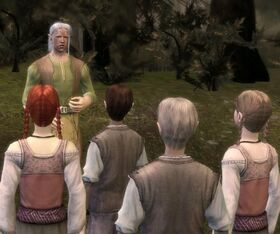
Every modern Dalish child is taught about the fall of the Dales by the clan elders.
There, see the Winter Palace at Halamshiral. Gaze upon its white walls and golden spires, built on the broken dreams of a people. Our people.
The human prophet Andraste was a slave in the Tevinter Imperium, as our ancestors were. When she rose up against them, we rose up with her. Together we fought for freedom. In gratitude and kinship, Andraste promised the elves a new land: the Dales. And although she died, her sons kept her promise.
Our people came from farthest Tevinter to claim this new land. Here, our journey ended. This was our Halamshiral. As we laid the first stone for the city, our people vowed that no human would ever set foot on our lands. The greatest of our warriors swore to uphold this vow. One by one they came, invoking the names of Elgar'nan and Mythal, Andruil and Ghilan'nain. Before all our gods, they dedicated themselves to Halamshiral, becoming our protectors, our Emerald Knights. They would ensure that the Dales remained free.
It was free. For over three centuries. But the humans and their new Andrastian Chantry would not let us be. They pushed against our borders. They sent missionaries to spread the word of their prophet. They sought ways to subjugate the People once more. When we refused, we angered them.
They destroyed us. Even the Emerald Knights could not stand against the might of their army, armored in faith. In the name of their Andraste, they burned Halamshiral, scattering us to the winds. They forgot that once, long ago, Andraste's followers and the elves marched together. They forgot that Andraste called Shartan "brother."
—A Promise Lost, as told by Keeper Gisharel to the young hunters of the Ralaferin clan on the outskirts of Halamshiral
—From Codex entry: The Dales: A Promise Lost- We could once again forget the incessant passage of time. Our people began the slow process of recovering the culture and traditions we had lost to slavery. But it was not to last. The Chantry first sent missionaries into the Dales, and then, when those were thrown out, templars. We were driven from Halamshiral, scattered.—From Codex entry: The Dales
- Like dragons they fly, glory upon wings.
- Like dragons they savage, fearsome pretty things.
- —Unknown poet, written of humans shortly before the fall of the Dales[4]
Throughout the years, the citizens of the Dales became increasingly isolationist, perhaps simply because they had learned to distrust humans during their long slavery, or maybe because they were seeking to regain the immortality that legend says contact with the humans had robbed them of. A likely contributor to their isolation was the rise of Kordillus Drakon I, who was conquering his neighboring city-states and forcibly converting his subjects to his particular Cult of the Maker, establishing the Orlesian Empire and the Chantry of Andraste; his massacre of people who followed other faiths, like the thousands of followers of the Daughters of Song who were slain by Drakon's forces, [5] could have also given the elves pause about their new neighbor and rising empire. Certainly Chantry missionaries would have been unwelcome in a land trying to maintain their autonomy from human rule and re-establish the old elven religion, but human historians also claim that the elves refused to trade with their neighbors and that Emerald Knights were posted at the borders to forestall visitors.[6]
In their attempt to maintain their independence and regain the lost glory of Elvhenan, the elves cut themselves off from the Orlesian Empire. Throughout the Second Blight, which lasted for most of the Divine Age, Chantry accounts claim the elves of the Dales remained neutral and unhelpful, although there is no indication that Orlais petitioned the Dales for assistance. However, there is an elven account of a Dalish presence in the Anderfels at this time who were fighting the darkspawn. [7] When the city of Montsimmard was nearly destroyed by darkspawn in 1:25 Divine, it is alleged that the elven army simply watched from nearby. Partly because of this, and other rumors that were being spread about the elves, the end of the Blight saw increasing hostility between the Dales and Orlais. According to human accounts, border skirmishes escalated into full-scale war after the elven forces attacked the Orlesian town of Red Crossing in 2:9 Glory. However, there is also reason to suspect the Chantry, which objected to the worship of the elven pantheon, of inciting fear and hatred of the elves by allegedly spreading false rumors of human sacrifice. The Dalish claim the war started after the Chantry sent templars into their sovereign territory after the elves kicked their missionaries out of the Dales.[6]
By 2:10 Glory, elven forces had captured Montsimmard and were on the doorstep of Val Royeaux. At this point, the Chantry called for a holy war against the elves that became known as the Exalted March of the Dales. While the elves eventually sacked Val Royeaux and pushed well into human lands, Halamshiral was conquered and the elves were completely crushed by 2:20 Glory. The Dales were appropriated by the Orlesians, who uprooted elven settlements and forbade worship of the elven gods.[1] Elves who accepted the Chantry's offered truce were spared and required to accept the Maker and live in slums, known as alienages, within human settlements, becoming the city elves.
Some elves, however, refused to give up their worship or their dream of their own homeland. These became the Dalish, retaining the name of their second lost homeland and vowing to keep elven language, lore and religion alive.
The Fifth Blight
While some contemporaries dispute whether the Fifth Blight was a true Blight or merely a large darkspawn resurgence, historians agree that it began in the swamps of the Korcari Wilds on the southeastern border of Ferelden in the year 9:30 Dragon.
King Cailan Theirin was swift in responding to the threat of encroaching darkspawn, gathering the royal army, every Grey Warden in his country, and sending a call for aid to the Fereldan nobility. The assembled armies laid a trap in the ruins of Ostagar, hoping to crush the force before it reached civilization, but they failed.
Darkspawn overran the defenders of Ostagar and decimated the king and his army. They continued their advance into Ferelden unopposed. Only two Grey Wardens managed to escape the slaughter. And somehow, they came into possession of ancient treaties, which compelled the races of men to join arms against the massing horde.
In desperation to find more allies, the Wardens journeyed into the Brecilian Forest, seeking the Dalish.[9]
When the Warden finds the Dalish elves, the Warden discovers that they are being destroyed by a virulent disease which is turning them all into werewolves. The clan keeper, Zathrian, asks the Warden's assistance in ridding them of the curse. He requests that the Warden find the first werewolf, Witherfang, and return with his heart to end the curse destroying his people. The quest takes the Warden through the Brecilian Forest to track down the lead werewolf.
If the Warden sided with the elves in "Nature of the Beast", the Dalish elves, too, will join the Grey Warden's growing army.
- At the end of Dragon Age: Origins, it is possible for the Hero of Ferelden to ask the new monarch of Ferelden to grant the Dalish their own lands if the Warden is of Dalish origin. Specifically the Hinterlands north of the Korcari Wilds, which includes the ruins of Ostagar. Alternatively, if the Warden is of Dalish origin and sacrifices themself to end the Blight, the Dalish will be given these lands. Regardless of the Hero's origin, if Dalish elves participated in the Battle of Denerim, it states that in time, many of the Dalish clans moved to new land provided for them in the south of Ferelden near Ostagar. The epilogue will then reveal that they settle these lands, though new political tensions arise.[10] This outcome was later changed to accommodate the storyline of Inquisition, where humans populate the Hinterlands instead of the Dalish.
Culture and clan life
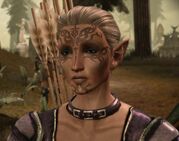
Dalish Hunter
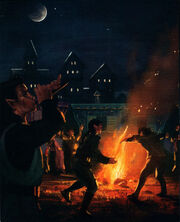
Dalish elves celebrating and entertaining near a human settlement[11]
“You were born among the Dalish elves: noble wanderers who refused to join the society of humans that subjugated their homeland so long ago. The Dalish travel the lands in tightly-knit clans, struggling to maintain their half-forgotten lore in a human world that fears and despises them.” ―Duncan at the beginning of Dalish Elf Origin
The Dalish travel around the more remote reaches of Thedas in aravels, special wagons with large triangular sails and rudder-like devices on the back. In addition to being pulled by Halla, aravels use magic to move through the forests quickly and easily.[12]
The Dalish are familiar with many natural remedies humans have forgotten or ignored, such as chewing pieces of bark from certain trees to cure a headache.[13]
For food, the Dalish rely mostly on hunting and foraging. They also make use of halla milk and related dairy products such as butter and cheese. The elves of southern Orlais eat the larvae of a wood-burrowing beetle.[14]
Roles among each clan are stringent and clearly defined. A keeper serves as a leader and spiritual guide, and working in tandem with them is a hahren, who reiterates the Elven lore and tends to the children. Other important positions are being the designated warleader, hearthmistress and crafter. There is also a designated Halla Keeper. Elves can also be a Hunter or a Healer. Each position has an apprenticeship stage, an example being how an elf must kill and present a beast of the forest all by themselves to become a fully-fledged hunter. The Dalish version of marriage is referred to as 'bonding'.
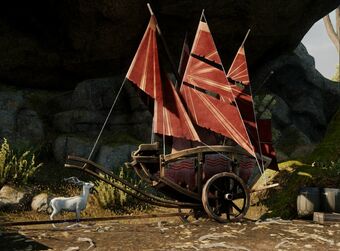
An aravel alongside a Halla in the Exalted Plains
Whilst they still lived in the Dales, the Dalish had at least one Lord called Hassandriel in 2:7 Glory, towards the end of the elven nation.[15] It was in essence based on an aristocratic/oligarchic model rather than simply a monarchy.
Along with their telltale aravels, the Dalish elves are also known for being the only race capable of forging ironbark, a unique substance stronger and lighter than steel, used to make their weapons and certain other items of clothing. For a typical hunter's armor, ironbark plates are combined with leather. The material can also be enchanted. For weapons, Dalish use daggers, arrows and nets. Ironbark weapons, along with carved halla horns, are highly valued and are used to trade with humans for things they cannot make on their own.
Dalish elves tend to keep to their own and avoid humans whenever they can, but will occasionally encounter human travelers, or venture near human settlements to trade. At the threat of these encounters becoming violent, a Dalish clan will likely withdraw before any real force of humans gets involved, but they will often still be willing to stand their ground. In the long run, hostilities with humans will likely end badly for the elves, especially if a human settlement decides that a certain clan has become more trouble than it is worth.
The Dalish clans themselves can also be quite different from each other. Some clans will get along fairly well with humans, and might even camp outside of settlements for long periods of time. Other clans are more infamous, living by banditry and hiding like guerrillas in the mountain passes.
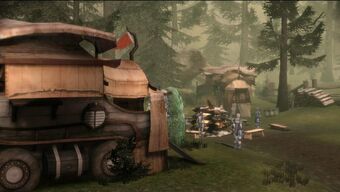
A Dalish camp
When Dalish elves die, their clan will bury them and plant a tree over their remains.[16] The dead are provided with an oak staff to help them along the path of the afterlife, and a cedar branch to scatter the ravens of Fear and Deceit who were once servants of Dirthamen.[17] If a clan is able to, they will bury their dead in a sacred burial site known as Var Bellanaris, which is located in the Exalted Plains.
Lore-keeping and education
- Main article: Education
“In time, the human empires will crumble. We have seen it happen countless times. Until then, we wait, we keep to the wild border lands, we raise halla and build aravels and present a moving target to the humans around us. We try to keep hold of the old ways, to relearn what was forgotten.” ―Gisharel, Keeper of the Ralaferin Clan[18]
Education among the Dalish appears to be mainly oral,[19] taught by hahrens who instruct through the use of lore and storytelling. The Dalish retain their history through oral tradition as well as books in some cases.[20] Children are highly valued among the clans.
Dalish clans rarely encounter each other in order to protect themselves; their diaspora is as much of a blessing as is a curse. Only once every decade or so do the Dalish clans all meet together, and their keepers, the elders and leaders of the Dalish who are responsible in keeping elven lore and magic alive, will meet together and exchange knowledge in a meeting called the Arlathvhen.
During such a time, the clans will recall and record any lore they have relearned since the past meeting, along with reiterating what lore they know already to keep their traditions as accurate and alive as possible. During such time, the clans will exchange relics dating from the two elven nations for safekeeping. The Dalish believe that all the relics they've preserved from the Dales and Arlathan belong to all the Dalish; such trades are seen as much of an act of sharing as it is a matter of trade, and the same is true even for talented elves. Merrill, for example, was born in the Alerion clan, but due to her magical talents she was given to the Sabrae clan to be the First of Keeper Marethari as clan Alerion already had a number of gifted elves.
A clan's "First," an apprentice mage under a Keeper, studies history and magic and attempts to preserve elven lore.[21] To avoid invoking the ire of Templars, each clan keeps a limit on the number of magically-gifted elves it has. Once that limit is reached, those additional elves are either shuffled around to other clans that are desperate for mages, as in Merrill's case, or, as in Minaeve's case, abandoned to the wilderness.
Philosophy
Many Dalish live by goddess of the hunt Andruil's code known as the Vir Tanadhal, meaning "Way of Three Trees" or "the Ways of the Hunter." It is made of three parts, taught by Andruil herself, which are:[22][23]
- Vir Assan ("Way of the Arrow") - fly straight and do not waver. "Be swift and silent," Andruil taught. "Strike true; do not waver. And let not your prey suffer."
- Vir Bor'Assan ("Way of the Bow") - bend but never break. "As the sapling bends, so must you. In yielding, find resilience; in pliancy, find strength."
- Vir Adahlen ("Way of the Forest" or "Way of the Wood") - together we are stronger than the one. "Receive the gifts of the hunt with mindfulness. Respect the sacrifice of my children. Know that your passing shall nourish them in turn."
The three parts of the philosophy are often strung together as a sort of mantra, which the Dalish will often end with the phrase, "We are the last of the elvhenan, and never again shall we submit." A rite of passage for hunters is to bring back the pelt of a creature the hunter has killed.[24]
Seldom spoken of, however, is a fourth way: the Vir Banal'ras, the "Way of Shadow." Dalish hunters assume it when a debt of blood must be repaid. Such hunters dedicate themselves to vengeance and nothing else. Thus were born the legends of Dalish assassins.
A few follow a different path, Sylaise's code known as Vir Atish'an, "The Way of Peace": Dalish following this calling learn the arts of the healer and the mender.[25]
When dealing with one another, Dalish elves may invoke Vir Sulevanin, a bargain by which an elf will complete a given task for another in return for something, such as a valuable clan item. Though the recipient of this bargain may dissent, they cannot reject an offer of Vir Sulevanin. Similarly, the elf offering the bargain must apparently agree to the task set to them whether it is desirable or not.[26]
Naming customs
Clans are named for the nobles from the Dales who originally founded the clan. Every Dalish surname preserves a lineage from someone, though not necessarily a clan founder. One noble clan founder could start a clan with some Emerald Knights, who would also pass on their names (e.g. clan founder Sabrae with Emerald Knights Mahariel and Talas). As the Dalish often trade people between each other, not everyone in a given clan is a descendant of its founder, and as such doesn't necessarily bear their name.[27]
Known dalish clans
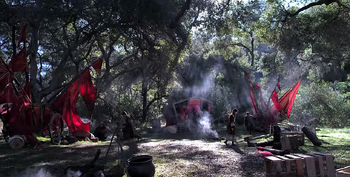
Yevven's clan was massacred by a Tal-Vashoth Saarebas.
- Alerion, the clan Merrill was born into.
- Ghilain, a clan that descends from Inquisitor Ameridan.
- Lavellan, the elven Inquisitor's clan.
- Ralaferin clan, whose Keeper is Elindra (formerly Gisharel), and whose First is Neria.[25]
- Sabrae, the Dalish Warden's clan.
- Tillahnnen, once headed by Keeper Ellathin[28]
- Virnehn, the clan of Thelhen and Mihris.
- Unnamed Velanna's clan.
- Unnamed Yevven's clan.
- Unnamed Zathrian's clan.
- Unnamed Ariane's clan.
- Unnamed clan that found young Loghain and Maric in the Korcari Wilds.
- Unnamed Hawen's clan
Notable Dalish elves
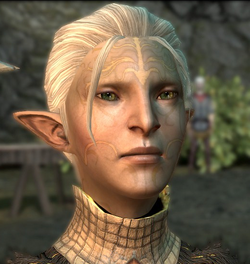
Keeper Marethari
- For a complete list, see Category:Dalish.
- The Warden, if playing the Dalish Elf Origin.
- The Inquisitor, if of elven origin.
- Abelas, a luckless Dalish woodworker.[29] Not to be confused with Abelas from Dragon Age: Inquisition
- Ariane
- Arianni
- Ashalle
- Cillian
- Gisharel
- Ilen
- Josmael
- Lanaya
- Lindiranae, the last wielder of Evanura, and the woman whose death marked the end of the Exalted March.
- Marethari
- Merrill
- Mihris
- Neria
- Rajmael, a Dalish general during the Exalted March against the Dales.[30]
- Sarel
- Seranni
- Solan, Keeper of Ariane's clan.[31]
- Tamlen
- Varathorn
- Velanna
- Yevven
- Zathrian
Notes
- Inquisition's introduction of the Dalish limiting the number of mages within a clan contradict the previous presentation of multiple mages in Zathrian's clan in Dragon Age: Origins and multiple dialogues from Merrill in Dragon Age II on the issue, including her background that reads she was moved to the Sabrae clan because magic is dying out among the Dalish.
- According to Zevran there are Dalish elves in Antiva City, but they are much more violent than those in Ferelden.[32]
- According to David Gaider, Dalish in Rivain have a semi-permanent settlement on the outskirts of the city of Llomerryn.[33] However, party banter during Act 2 in Dragon Age II between Isabela and Merrill suggests that the Dalish have not yet reached Llomerryn (at least since Isabela was last there).
- It is unknown whether or not Dalish elves live longer than the city elves, since David Gaider and Mary Kirby have given conflicting information regarding their longevity.[34][35]
Trivia
- The original inspiration for the Dalish came from the Roma and Jewish people, and then it evolved into North American Natives.[36]
- Young Dalish elves are given wooden puzzles called "June's knot," that have no solution to occupy their time.[37]
Gallery
Codex entries
![]() Codex entry: Vallaslin: Blood Writing
Codex entry: Vallaslin: Blood Writing
References
| ||||||||||||||||||








